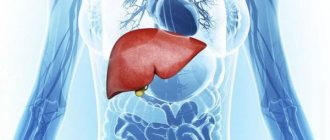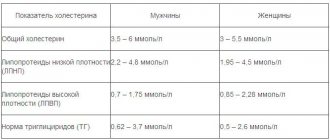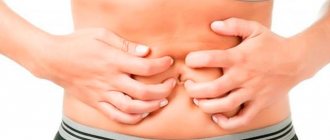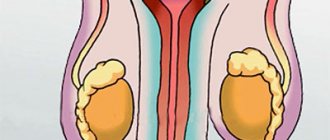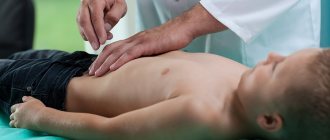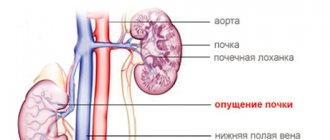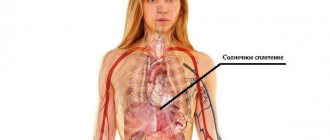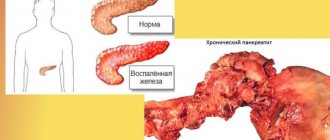Abdominal pain on the left side near the navel is a fairly common symptom. Localization of pain on the left side is more common than right-sided pain. This is due to the physiological characteristics and location of internal organs. In some cases, such symptoms may indicate digestive problems, but if the pain occurs regularly or is of high intensity, you should consult a doctor to rule out the possibility of more severe pathologies, such as intestinal or renal cancer.
Abdominal pain to the left of the navel
Localization and nature of pain
Pain in the umbilical region can be sharp or dull, cramping, aching, cutting. A stabbing pain is common and may feel like intense burning and tingling. Weak, aching pain usually indicates the onset of an inflammatory process, which may involve the spleen, pancreas, kidneys, ovaries and other organs located in the left quadrant.
When diagnosing, the localization of pain is of great importance. If pain occurs predominantly in the lower abdomen, it is necessary to exclude genitourinary pathologies and diseases of the large and small intestines. Women need to undergo a preventive examination by a gynecologist, since gynecological pathologies can cause similar symptoms: endometriosis, uterine fibroids, salpingoophoritis (inflammation of the fallopian tubes and ovaries).
Location of organs in the abdominal cavity
If pain is localized in the upper abdomen on the left side, it is necessary to check the functioning of the spleen, pancreas, stomach and esophagus.
Note! In rare cases, acute pain to the left of the umbilical ring may indicate injuries and bruises to internal organs (including the lower border of the left rib). If a comprehensive examination does not reveal any diseases, it is necessary to take an x-ray of the chest and abdominal organs.
Diagnostics
If the pain on the left side in the navel area is acute, spastic, causing severe discomfort, you should immediately call an ambulance. This can manifest itself as appendicitis or gastroenterocolitis, which require surgical intervention and prompt resolution.
When the pain is moderate, but does not go away completely, you should definitely consult a therapist. He will collect a complete history, in which he will record his sensations during palpation, the nature of the pain, as well as the general condition of the patient. With this data, you can go to a more highly specialized doctor - a gastroenterologist, who will conduct a number of additional studies that will confirm the diagnosis:
Ultrasound of the abdominal cavity; palpation of the diseased area; X-ray (if there is abdominal trauma)
https://youtu.be/kBNo6GhvPiI
If it hurts in the upper part on the left side of the navel
The appearance of stabbing pain, localized to the left of the umbilical ring, most often indicates diseases of the pancreas. In 65% of cases, patients with these symptoms are diagnosed with pancreatitis. This is an inflammation of the pancreas, in which degenerative changes occur in the tissues of the organ. Any symptoms of this disease intensify after eating food, especially if it contains a large amount of fat. Increased pain can be noticed after a heavy meal, as well as in cases where the break between meals is more than 6-8 hours.
What does pain in the navel area indicate?
Very often, tingling and pain to the left of the navel appear in women who limit themselves in diet in order to lose weight. Starvation diets, as a rule, end in failure and consumption of large amounts of food, which ends in digestive disorders and dyspepsia.
Signs of pancreatitis include the following symptoms:
- pain in the umbilical area, epigastrium or abdominal space;
- sensation of a “lump” in the throat;
- bad breath;
- heartburn;
- nausea (worsens after heavy meals);
- stool disorders.
Signs of pancreatitis
Treatment of pancreatitis includes taking digestive enzymes (Creon, Pancreatin), drugs to reduce gastric secretion (Omeprazole, Omez) and symptomatic therapy to eliminate heartburn and reduce the negative impact on the mucous membranes of the stomach (Almagel). .
Intestinal infections
Diarrhea of infectious origin is another possible cause of pain in the upper abdomen on the left side of the navel. In some cases, diarrhea may be the only clinical manifestation of the disease, but most often it is accompanied by other symptoms. These include:
- increased body temperature;
- signs of general intoxication (chills, weakness, drowsiness, fever);
- vomiting (most often repeated);
- stomach ache.
Diseases depending on the location of pain
Pain during intestinal infections is paroxysmal and is caused by muscle spasms. The intensity is usually strong. To relieve pain in this case, you can use any antispasmodic, for example, Papaverine or No-shpu. To destroy the bacterial flora, broad-spectrum antibiotics (Enterofuril) are prescribed. At the same time, rehydration therapy is carried out using saline solutions (Regidron) and cleansing the body using sorbents (Activated Carbon, Polysorb, Neosmectin).
Volvulus
A very serious pathology, which is a form of intestinal obstruction. Intestinal obstruction is a disease in which digested food cannot move through the digestive tract and remains to rot in the intestines. Pathology is almost always accompanied by severe intoxication. If rotting products and toxins enter the bloodstream, a purulent form of sepsis with signs of a pronounced inflammatory process may develop.
Types of volvulus
Volvulus is the twisting of intestinal sections around its axis. Sometimes the intestine can twist around the mesentery - a ligament connecting the posterior wall of the peritoneum with the intestinal tube (from the parietal layer to the visceral layer). The pathology is always accompanied by pain in the lower abdomen, which can move to the upper part of the left quadrant and concentrate in the umbilical region.
Important! Volvulus is a deadly surgical pathology, so if you suspect this disease (lack of bowel movements for several days combined with a rise in temperature and abdominal pain), you must immediately go to the hospital.
Abdominal aortic aneurysm
The abdominal aorta is a large blood vessel through which blood, enriched with nutrients and oxygen, flows from the heart to the abdominal organs. An aneurysm is a bulge in the wall of a vessel that can rupture the aorta. Alarming symptoms of pathology develop within several hours. The patient experiences a sharp stabbing pain in the upper abdomen and to the left of the navel, dizziness begins, and loss of consciousness is possible. Blood pressure drops sharply; in especially severe cases, blood pressure readings can reach critical levels.
Types of abdominal aortic aneurysm
Important! Aneurysm rupture is a fatal pathology. If a person has symptoms indicating possible abnormalities of the blood vessels (which include an aneurysm), it is necessary to immediately contact a vascular surgeon.
Rare causes
What to do for pain in the navel
In some cases, pain to the left of the navel can be caused by other pathologies, such as kidney disease or intestinal cancer. In this case, the localization of pain will depend on which part of the organ is affected. The frequency of diagnosing peri-umbilical pain on the left side is presented in the table below.
| Cause | Frequency of pain to the left of the umbilical ring |
| Chronic renal failure, infectious and inflammatory kidney diseases | 7 % |
| Bowel cancer | 4 % |
| Pancreas cancer | 2,1 % |
| Urolithiasis disease | 8 % |
| Pneumonia | ≤ 2,9 % |
Video - Why does the left side in the lower abdomen hurt?
On right
On the right, just above the middle part of the abdomen, are located: the right kidney, the ascending colon.
Induration near the navel on the right, pain and discomfort may appear due to the following provoking factors:
- Appendicitis, with the appearance of troubles and inflammation of the appendix with a displacement to the right. Usually causes acute pain discomfort accompanied by fever and nausea. Patients need to urgently contact a surgeon.
- Lipoma as a benign wen or a consequence of blockage of the sebaceous glands. The tumor, soft to the touch, may increase in size and roll slightly under the skin. Requires surgery to remove.
- Atheroma in the form of a cyst up to 3 cm in diameter, tightly sealed to the skin. Perhaps the appearance of a dark dot in the middle of the abdomen, as a fact of gland blockage. Atheroma has an inflammatory course, so the signs are hotness to the touch, pain in the area. Requires surgical intervention to remove it.
- Fibrosarcoma is a malignant tumor up to 2-15 mm in diameter. It looks like a smooth scar (bump) on the skin, mobile and painful. The place in the middle part of the square of the peritoneum is tense, atrophies over time and can become covered with crust and erosion. Requires surgical removal.
- Diverticulitis is a type of hernia with the accumulation of intestinal contents as the inflammatory process develops. Provocateurs – infection with worms, heredity, unhealthy diet, decreased muscle tone. Symptoms: upset stool, passing blood particles, increased temperature, pain in the inflamed area. Treatment is antibiotics or surgery.
If there is pain in the lower abdomen to the left of the navel
In most cases, such pain is caused by intestinal pathologies, genitourinary disorders or gynecological diseases. Only a doctor can accurately determine the cause of pain, taking into account the existing symptoms and the results of laboratory and diagnostic tests.
Gynecological diseases
In women, similar pain can occur with female diseases, for example, endometrial pathologies. Painful sensations are usually nagging in nature and are additional symptoms, so they cannot be considered as the main clinical manifestations. Nagging (sometimes paroxysmal) pain in the peri-umbilical region on the left or right side may indicate endometrial hyperplasia or endometriosis, as well as purulent-inflammatory processes in the uterine cavity.
What is endometriosis
With benign formations (myomas and fibroids) of the uterus, the pain is of mild or moderate intensity and intensifies during sexual intercourse or intense physical activity. Other symptoms for these pathologies may be absent, so tumors can remain undetected for a long time.
Gynecological diseases in most cases have similar symptoms, in the presence of which one can suspect that the functions of the reproductive organs are impaired. Pathological symptoms include:
- bleeding from the vaginal tract;
- periodic increase in low-grade fever;
- increased pain during menstruation or intimacy;
- symptoms of anemia (weakness, headaches, nausea, dizziness);
- menstrual irregularities.
Salpingo-oophoritis from the inside
Inflammation of the appendages (salpingoophoritis) can also begin with a slight tingling on the left side of the navel (if the lesion affects the left appendage), turning into intense sharp or cutting pain, spreading to the lower and lateral abdomen.
Important! Severe pain to the left of the umbilical ring may indicate an ectopic pregnancy if the fertilized egg is implanted in the left fallopian tube, left ovary, or left side of the abdominal cavity. If, against the background of such signs, a jet pregnancy test shows two stripes, you must urgently consult a specialist, since even with a pathological location of the embryo, the result of express diagnostics will not differ from diagnosing a normal pregnancy.
Video - Possible causes of abdominal pain
Diseases of the genitourinary system
If pain to the left of the navel occurs against the background of symptoms characteristic of diseases of the urinary tract, you should consult a urologist. One of the most likely pathologies with such symptoms is cystitis. This is an inflammatory process on the walls of the bladder, which is often infectious in nature. Kidney pathologies (glomerulonephritis, pyelonephritis) can also cause pain in this area, but their intensity is usually higher.
This group of diseases is characterized by a general clinical picture:
- frequent and painful urination;
- burning and stinging at the beginning of emptying the bladder;
- temperature increase;
- cloudy urine (precipitation and blood streaks may appear);
- discomfort during intimacy.
Condition of the kidneys with pyelonephritis
Treatment of cystitis and diseases of the renal system in most cases requires the use of antibiotics (Amoxicillin, Ampicillin, Flemoxin). Also used are herbal antiseptic agents (“Canephron”, “Cyston”) and herbal preparations to remove excess fluid and eliminate swelling (“Brusniver”).
Intestinal pathologies
Any disturbances in the functioning of the intestines can cause abdominal pain from the navel. The accumulation of gases caused by dietary errors and other dyspeptic disorders cause intestinal spasms and severe, cramping pain in the abdomen. Inflammatory bowel diseases, for example, colitis, enteritis or diverticulitis, can also cause pathological symptoms.
Symptoms of colitis
Intestinal diseases may be accompanied by the following signs, by which they can be easily distinguished from other diseases. These include:
- bowel problems (constipation or diarrhea);
- change in color and consistency of stool;
- the presence of streaks of blood, mucus and uncharacteristic inclusions in the stool;
- abdominal pain of different localization;
- painful bowel movement.
Important! These symptoms may indicate malignant processes in the intestines, so intestinal disorders cannot be treated without consulting a doctor.
Video - Why does the lower abdomen hurt?
What not to do if pain occurs
Even though people call a doctor when they experience abdominal pain, before he arrives they can experiment with traditional methods to relieve or alleviate the pain. But in most cases, such measures can only make things worse.
First aid for abdominal pain
Before being examined by a doctor, patients are prohibited from:
- take laxatives to empty the intestines;
- give cleansing enemas yourself;
- eat any food;
- Try to relieve pain with painkillers. As an exception, antispasmodics can be taken, but this is provided that the patient has no symptoms of inflammation of the appendix;
- apply warm compresses to the sore spot.
What not to do if your stomach hurts?
Any abdominal pain, regardless of its location, should be a reason to consult a doctor. Before examination by a specialist, it is not permitted to:
- apply heat to the sore spot;
- take painkillers (with the exception of antispasmodics if the patient does not have signs of appendicitis);
- eat food;
- give enemas;
- try to empty the intestines using laxatives.
Before going to the hospital or arriving an ambulance, it is necessary to provide the patient with rest and avoid any physical activity. Dry ice can be used to relieve pain.
Pain to the left of the navel is not a specific symptom characteristic of certain diseases, but its occurrence cannot be ignored. There are many reasons that can trigger the occurrence of unpleasant sensations, so it is almost impossible to make a correct diagnosis at home. To determine what exactly caused the pain in the peri-umbilical region, it is necessary to take tests and undergo additional examinations, which may include ultrasound diagnostics, computed tomography, radiography of the peritoneal and chest organs, colposcopy and other types of studies. Colitis in the right side of the lower abdomen, read on our website.
Classification of pain
Doctors share many different types of pain (more than ten) that can occur to the left of the navel. The table below shows the most common of them.
Pain to the left of the navel varies
Table. Types of pain in the navel by nature.
| Nature of pain | Possible reasons |
On a note! You cannot make a diagnosis based only on an analysis of the pain that has arisen, since it is not the main criterion. Only a correct diagnosis will allow the doctor to make an accurate diagnosis, so if you suspect the development of one or another pathology, do not worry ahead of time, because even severe abdominal pain can be the result of intoxication of the body or a banal disorder of the digestive system.
Causes of abdominal pain
Crohn's disease
If a man or woman has a stomach ache, this may be a symptom of Crohn's disease. This pathology, as a rule, has a chronic course, but if its acute form develops, then surgical intervention is advisable. No one knows the exact reason for the development of this disease. Scientists suggest that the main factor may be genetic predisposition, and secondary factors may be smoking, food allergies, stress, and immune system characteristics.
With Crohn's disease, in addition to constant stomach pain, symptoms such as frequent pasty stools with blood, fever, lack of appetite, weight loss, anal fissures or fistulas may appear. In addition to the medication prescribed by the doctor, the patient is prescribed a strict diet. During the active phase of the disease, split meals of about 6 times a day are recommended; the foods consumed should contain many vitamins and protein. During the chronic course of the disease, traditional medicine recipes can be used to alleviate the condition:
- When thinking about what to do if your stomach hurts, you should remember about a decoction of licorice root. This remedy is considered an excellent pain reliever for cramps. To prepare it, 1.5 g of root is peeled, crushed and poured with a glass of water, boiled for 15 minutes over low heat. Drink three times a day. However, it should be remembered that the use of this decoction is contraindicated for hypertension.
- For any form of Crohn's disease, it is recommended to drink chamomile tea (1 teaspoon of dry plant per 250 ml of boiling water). You can drink it 3-4 times throughout the day.
Methods of treating the above diseases
A slight protrusion in the lower abdomen is observed in the early stages of pregnancy. This phenomenon is especially pronounced in thin women. If pain is felt when pressing on the tubercle or other alarming symptoms are present, the woman should consult a doctor. Other reasons for the appearance of bumps on the stomach include:
- development of adhesive processes in the uterus;
- ovarian torsion;
- the appearance of appendage cysts of significant size.
Often, hard formations appear after childbirth during a cesarean section. They are localized in the suture area and can cause severe discomfort. This phenomenon is caused by the fact that during the healing process, injured areas of the body are covered with dense scar tissue. When using low-quality suture materials against the background of developing autoimmune reactions, ulcers may form under the skin. This phenomenon is accompanied by burning, itching, and the appearance of discharge from the scar.
If a lump occurs in the navel, you should consult a medical specialist. Only a doctor can determine what kind of pathology this is and why it appeared. Treatment is selected based on the cause of the lump on the abdomen.
Umbilical hernia
Most often it causes a lump near the navel. Pathology can appear in people of any age: both infants and the elderly. When pressing on the hernia, coughing, or straining the abdomen, intense pain occurs.
Ovarian cyst
Cysts on the ovaries can be located on both the right and left. The pain can also be of a different nature, so it is impossible to determine the pathology on your own. Treatment may include both medication and surgery. Sometimes folk remedies also give a good effect:
- 15 g of acacia color (can be replaced with 2 tsp of dry acacia bark) is poured with 250 ml of vodka, closed with a tight lid and put away in a dark place for a week. After the expiration date, the infusion is filtered. Take 20 ml three times a day. The full course of treatment is 1 month.
- You can fight ovarian cysts with regular baking soda, which housewives use in cooking. So, to prepare the medicine, 1 tbsp. l. soda is quenched with a glass of vinegar and 200 ml of vodka is added. The resulting mixture is dissolved in 3 liters of water. Next, take a cotton cloth, soak it in a soda solution and apply it to the lower abdomen overnight as a compress. The duration of the course is 2-3 weeks, after which you need to take a two-week break. If there is a tumor, such procedures are contraindicated.

